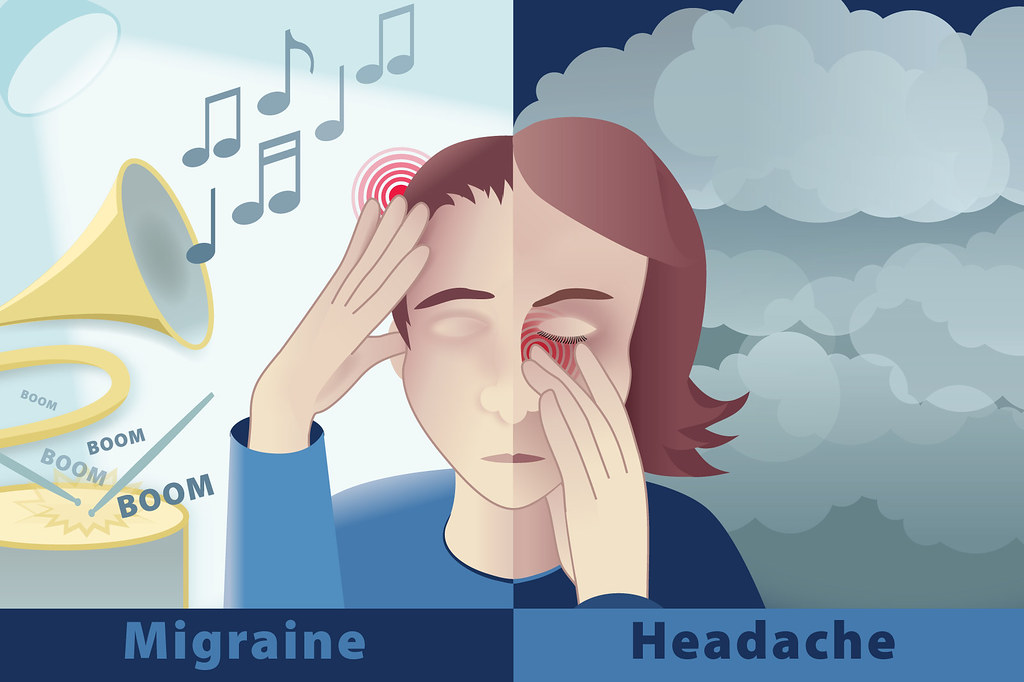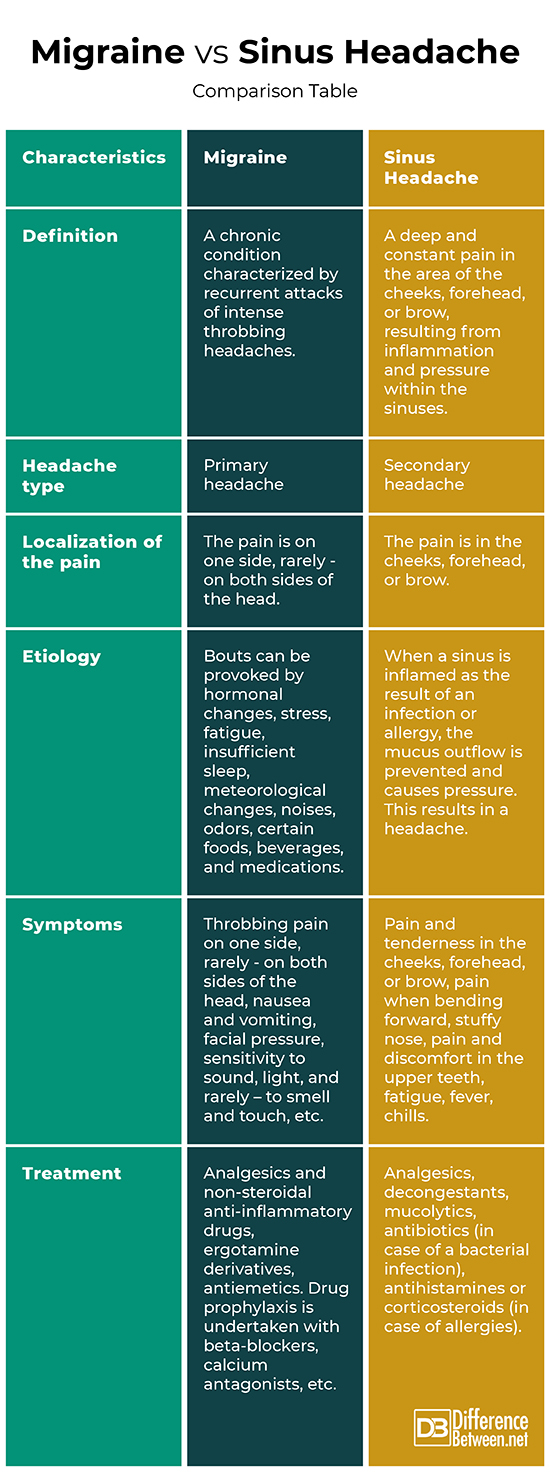Difference Between Migraine and Sinus Headache
Migraine and sinus headache can be confused because of similar symptoms. Both conditions often get worse if the patient bends forward. Migraine can have some nasal signs, like facial pressure, congestion, nasal discharge. About 90% of people who visit a doctor for sinus headaches actually have a migraine. However, the two conditions have different etiology, character, and therapy, and the proper diagnose is important for the treatment.

What is Migraine?
Migraine is a chronic condition characterized by recurrent attacks of an intense throbbing headache.
During a migraine attack, there is a sharp dilation of the blood vessels in the dura mater, preceded by their spasm. As a result of the activation of the neurons of the trigeminal nerve their endings, reaching the walls of the blood vessels, secrete biologically active substances, causing focal neurogenic inflammation and edema of the vessels.
The etiology of migraine is not fully understood however, it is known that heredity plays an important role. Bouts can be provoked by:
- Hormonal changes (e.g. menstruation)
- Stress
- Fatigue
- Insufficient sleep
- Meteorological changes
- Prolonged sun exposure
- Noise
- Certain odors
- Certain foods and beverages – chocolate, nuts, citrus fruits, sausages, cheese, coffee, tea, alcohol
- Medications – nitro drugs, hormonal contraceptives, oral antidiabetic drugs.
In general, migraine has four stages, but not every patient with migraines goes through all of them. The stages and the respective symptoms are:
- Prodrome – a day or two before a migraine:
- Neck stiffness
- Mood changes
- Increased thirst
- Food cravings
- Frequent yawning.
- Aura – before or during migraines:
- Vision loss
- Seeing flashes of light, bright spots, different shapes
- Hearing noises
- Pins and needles sensations in the limbs
- Numbness or weakness in the face.
- Attack:
- Pain on one side, rarely – on both sides of the head
- Pain in the head that throbs or pulses
- Nausea and vomiting
- Facial pressure
- Congestion, nasal discharge
- Sensitivity to sound, light, rarely – to smell and touch.
- Post-drome
- Tiredness
- Confusion
- Pain after sudden head movement.
The diagnosis of migraine is based on the anamnesis data, which show the characteristic features of the headache and the accompanying symptoms, the family history, changes of pain after sleep, typical provoking factors, etc.
Migraine treatment requires avoidance of the provoking factors, e.g. via a specific diet.
In case of an attack, it is recommended to place the patient in a supine position in a quiet darkened room. Medications used during an attack are:
- Analgesics and non-steroidal anti-inflammatory drugs
- Ergotamine derivatives
- Antiemetics against nausea and vomiting.
If the attacks occur more than 3 times a month, drug prophylaxis is undertaken for several months with:
- Beta-blockers
- Calcium antagonists
- Tricyclic antidepressants
- Non-steroidal anti-inflammatory drugs.

What is Sinus Headache?
A sinus headache is a deep and constant pain in the cheeks, forehead, or brow, resulting from inflammation and pressure within the sinuses.
Each sinus produces mucus, draining out of the channels of the nose. When the sinus is inflamed as the result of an infection or allergy, the mucus outflow is prevented and causes pressure. This results in a headache.
The sinus headache is caused by allergies, infections, or other irritants, most often by viral infections.
The symptoms of a sinus headache include:
- Pain and tenderness in the cheeks, forehead, or brow
- Pain when bending forward
- Stuffy nose
- Pain and discomfort in the upper teeth
- Fatigue
- Fever
- Chills.
Sinus headache is a secondary headache, i.e. there is an underlying problem, causing it.
The diagnosis of sinus headache is based on the anamnesis data, which show the characteristic features of the headache and the accompanying symptoms, the family history, changes of pain after sleep, typical provoking factors, etc.
The pain and pressure of a sinus headache need treatment of the underlying cause.
The treatment depends on the severity of the infection. In mild conditions is often recommended forehead, or brow to let the infection resolve by itself. Symptomatic treatment may be applied for the treatment of fever and pain.
Some home remedies, as irrigation with a saline solution, breathing in steam, applying a wet, warm washcloth to the face, etc. can be used to limit the symptoms.
Medications which can be applied to treat the sinus headache include:
- Analgesics
- Decongestants
- Mucolytics
- Antibiotics (in case of a bacterial infection)
- Antihistamines or corticosteroids (in case of allergies).
Difference Between Migraine and Sinus Headache
Definition
Migraine: Migraine is a chronic condition characterized by recurrent attacks of intense throbbing headaches.
Sinus Headache: A sinus headache is a deep and constant pain in the area of the cheeks, forehead, or brow, resulting from inflammation and pressure within the sinuses.
Headache type
Migraine: The migraine is a primary headache.
Sinus Headache: The sinus headache is a secondary headache.
Localization of the pain
Migraine: The pain is on one side, rarely – on both sides of the head.
Sinus Headache: The pain is in the cheeks, forehead, or brow.
Etiology
Migraine: The etiology of migraine is not fully understood, the heredity plays an important role. Bouts can be provoked by hormonal changes, stress, fatigue, insufficient sleep, meteorological changes, noises, odors, certain foods, beverages, and medications.
Sinus Headache: When a sinus is inflamed as the result of an infection or allergy, the mucus outflow is prevented and causes pressure. This results in a headache.
Symptoms
Migraine: The symptoms during the migraine attack include throbbing pain on one side, rarely – on both sides of the head, nausea and vomiting, facial pressure, sensitivity to sound, light, and rarely – to smell and touch.
Sinus Headache: The symptoms of a sinus headache include pain and tenderness in the cheeks, forehead, or brow, pain when bending forward, stuffy nose, pain and discomfort in the upper teeth, fatigue, fever, chills.
Treatment
Migraine: Medications used during migraine attacks include analgesics and non-steroidal anti-inflammatory drugs, ergotamine derivatives, antiemetics. Drug prophylaxis is undertaken with beta-blockers, calcium antagonists, etc.
Sinus Headache: Medications which can be applied to treat the sinus headache include analgesics, decongestants, mucolytics, antibiotics (in case of a bacterial infection), antihistamines or corticosteroids (in case of allergies).
Migraine Vs. Sinus Headache: Comparison Table

Summary of Migraine and Sinus Headache
- Migraine is a chronic condition characterized by recurrent attacks of intense throbbing headaches.
- A sinus headache is a deep and constant pain in the area of the cheeks, forehead, or brow, resulting from inflammation and pressure within the sinuses.
- The migraine is a primary headache, while the sinus headache is a secondary one.
- In migraine, the pain is on one side, rarely – on both sides of the head, while in sinus headache it is in the cheeks, forehead, or brow.
- The etiology of migraine is not fully understood; however, it is known that heredity plays an important role. Sinus headache is caused by inflammation of the sinus which prevents the outflow of the mucus and causes pressure and headache.
- The symptoms during a migraine attack include throbbing pain on one side, rarely – on both sides of the head, nausea and vomiting, facial pressure, sensitivity to sound, light, and rarely – to smell and touch. The symptoms of a sinus headache include pain and tenderness in the cheeks, forehead, or brow, pain when bending forward, stuffy nose, pain and discomfort in the upper teeth, fatigue, fever, chills.
- Medications used during migraine attacks include analgesics and non-steroidal anti-inflammatory drugs, ergotamine derivatives, antiemetics. Drug prophylaxis is undertaken with beta-blockers, calcium antagonists, etc. Medications which can be applied to treat the sinus headache include analgesics, decongestants, mucolytics, antibiotics (in case of a bacterial infection), antihistamines or corticosteroids (in case of allergies).
- Difference Between Gallstones and Cholecystitis - September 5, 2021
- Difference Between Constipation and Cramping - August 4, 2021
- Difference Between Whole Genome Sequencing and Microarray - May 6, 2021
Search DifferenceBetween.net :
Leave a Response
References :
[0]Image credit: https://www.flickr.com/photos/joandragonfly/39384098854
[1]Image credit: https://en.wikipedia.org/wiki/Aerosinusitis#/media/File:Nnh_front.svg
[2]Jamieson D. Headache Medicine: Questions and Answers. New York: Demosmedical. 2008. Print.
[3]Tepper, S., D. Tepper. The Cleveland Clinic Manual of Headache Therapy: Second Edition. Berlin: Springer. 2014. Print.
[4]Warrell, D., T. Cox, J. Firth. Oxford Textbook of Medicine, Vol. 2. Oxford: Oxford University Press. 2010. Print.
